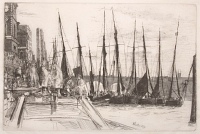Etchings Institutions search term: british museum
Billingsgate | ||
| Number: | 51 | |
| Date: | 1859 | |
| Medium: | etching and drypoint | |
| Size: | 152 x 223 mm | |
| Signed: | 'Whistler.' to right of centre | |
| Inscribed: | '1859.' at lower right | |
| Set/Publication: | 'The Portfolio', London, 1878 | |
| No. of States: | 9 | |
| Known impressions: | 125 | |
| Catalogues: | K.47; M.46; T.34; W.45 | |
| Impressions taken from this plate (125) | ||
TECHNIQUE
Once the missing parts of the figures were re-etched, the plate was complete, but the etching was not widely circulated until the copper plate was sold to Philip Gilbert Hamerton (1834-1894) 11 (see Printing, below).
11: Philip Gilbert Hamerton, ed,The Portfolio, An Artistic Periodical, London: Seeley, Jackson, and Halliday, Fleet Street, January 1878, p. 8.
PRINTING
12: See MARKET AND EXHIBITIONS: PUBLICATION.
 ) and in black ink on cream laid Japan (
) and in black ink on cream laid Japan ( ) and grey Japan (
) and grey Japan ( ). The third state was printed in black ink, on a dark cream or buff wove paper (
). The third state was printed in black ink, on a dark cream or buff wove paper ( ,
,  ) and on laid paper (
) and on laid paper ( ,
,  ). A proof of the fourth state is also in black, on cream laid paper (
). A proof of the fourth state is also in black, on cream laid paper ( ), and indeed the few impressions of the next three states are all in black ink (
), and indeed the few impressions of the next three states are all in black ink ( ,
,  ,
,  ).
). ) before the edition was printed by Goulding. These are original prints, printed from the copper plate, although not printed by the artist. According to Kennedy, an edition of one hundred impressions was printed on Japanese paper, and a further unspecified number were printed and bound in the journal Portfolio. 13
) before the edition was printed by Goulding. These are original prints, printed from the copper plate, although not printed by the artist. According to Kennedy, an edition of one hundred impressions was printed on Japanese paper, and a further unspecified number were printed and bound in the journal Portfolio. 13
13: Kennedy 1910 (cat. no. 47) p. 18.
 ,
,  ,
,  ) and probably are from this pre-publication print-run, but they certainly have not survived in the numbers that Kennedy suggests. Other impressions of the eighth state are printed in dark brown ink on pale cream wove paper (
) and probably are from this pre-publication print-run, but they certainly have not survived in the numbers that Kennedy suggests. Other impressions of the eighth state are printed in dark brown ink on pale cream wove paper ( ) and on dark cream laid paper (
) and on dark cream laid paper ( ), and in black ink on ivory wove paper (
), and in black ink on ivory wove paper ( ), but these were not signed by the artist.
), but these were not signed by the artist.14: Philip Gilbert Hamerton, ed.,The Portfolio, An Artistic Periodical, London: Seeley, Jackson, and Halliday, Fleet Street, January 1878, pp. 8-9.
 ).
). ,
,  ).
).15: S.G.W. Benjamin, A Group of Etchers, New York: Dodd, Mead and Company, 1882, n.p.
16: The Toledo Museum of Art, Documentary Sheet for cancelled plate, acc. no. 1927.57.
